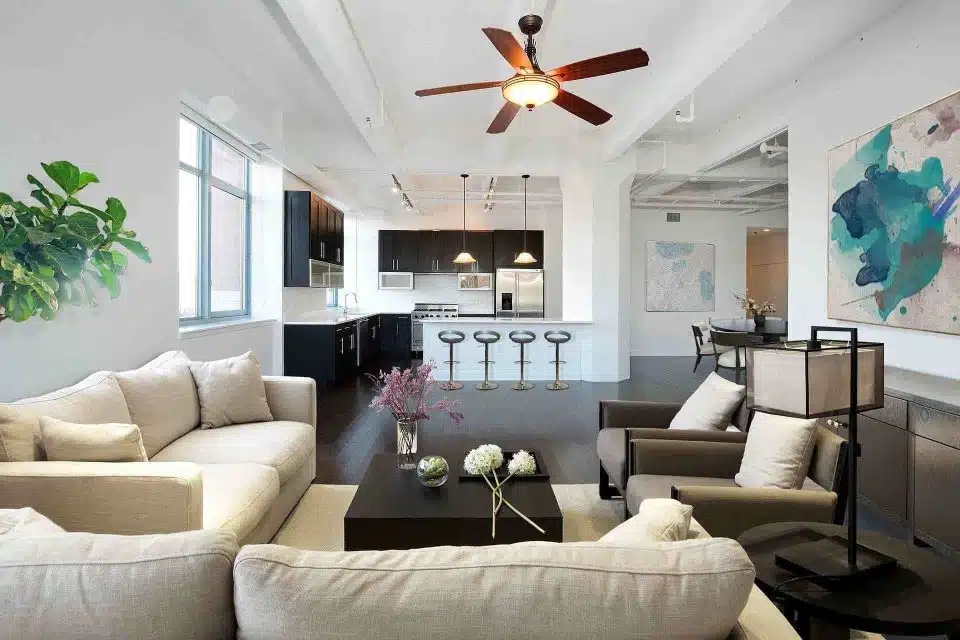Last Updated on December 14, 2024 by Admin
Lighting is one of the most powerful tools in architectural design. It does more than brighten a space — it shapes how we feel, work, and connect with our surroundings.
Whether it’s the warm glow of a pendant lamp over a dining table or the sleek, modern look of recessed LEDs, thoughtful lighting transforms rooms into experiences.
For architects, mastering indoor lighting techniques is about blending creativity with functionality to craft spaces that are not only beautiful but also practical and adaptable to different needs.
Table of Contents
Layered Lighting for a Multi-Dimensional Effect
Layered lighting combines three types of lighting: ambient, task, and accent. This is to create depth and functionality in a space.
For example, in an open-plan living area, ceiling-mounted ambient lights can set the mood, while pendant task lighting illuminates kitchen islands, and recessed accent lights highlight architectural details like textured walls or art pieces. This combination ensures that every corner of the room serves its purpose without feeling over- or under-lit.
Smart Lighting for Effortless Customization
Integrating smart lighting systems allows users to adapt spaces to their needs effortlessly. Smart bulbs from brands like Sunmory enable remote control of brightness, color temperature, and even light schedules via mobile apps or voice commands.
Architects can create designs that evolve with a user’s lifestyle, from dimming the lights for a cozy evening to brightening workspaces during the day.
Daylighting for Sustainability and Wellness
Daylighting maximizes natural light to reduce energy consumption and enhance indoor air quality. By strategically placing windows or skylights, architects can flood spaces with natural light, improving mood and productivity.
This approach not only saves energy but promotes wellness, as exposure to natural light supports better sleep and mental health. With advanced window technologies like Low-E glass, daylighting is more effective than ever, creating sustainable, healthier environments.
Dynamic LED Lighting for Versatility
LED lights offer flexibility in brightness, color, and energy efficiency, making them a go-to choice for modern design. These lights can easily shift from warm, relaxing tones to cooler, bright lights for working. LED strips, often used under cabinets or along ceilings, provide sleek, subtle lighting.
LED’s adaptability allows architects to design functional spaces that also enhance the room’s atmosphere, with the added benefit of long-lasting, energy-efficient performance.
Backlighting to Create Visual Drama
Backlighting places a light source behind an object to create a glowing effect, adding drama and depth to a space. It can highlight architectural features or artwork, making them stand out.
For instance, backlit panels behind furniture or textured walls create a soft, ambient glow. This technique adds visual interest and can turn ordinary features into striking elements, offering architects a way to enhance both aesthetics and functionality in a room.
Statement Pendant Lighting for Bold Design
Pendant lighting can serve as both functional and striking design elements in any room. Whether used as a single statement piece or in clusters, pendant lights draw attention and add personality. In spaces like dining areas or entryways, large or custom pendants can create a dramatic focal point.
These lights can also be used for task lighting, providing a blend of form and function that elevates the overall design.
Color Temperature to Set the Mood
Color temperature, measured in Kelvin, affects the mood and function of a space. Warm lighting (2700K–3000K) creates a cozy, inviting atmosphere, while cooler light (4000K–5000K) is ideal for workspaces.
Architects can use different color temperatures in one room to define areas for specific activities. For example, a dining area might use warm tones to promote relaxation, while a kitchen could use cooler light for better task visibility. This approach enhances both the ambiance and practicality of a space.
Shadow and Texture with Accent Lighting
Accent lighting is perfect for highlighting architectural features or creating shadows that add depth and texture to a room. Placing spotlights or uplights near textured surfaces like brick or wood brings these materials to life, adding visual interest.
This technique creates a dynamic atmosphere by casting shadows that make the space feel more layered and dramatic. Accent lighting can transform a simple feature into a focal point, enriching the overall design.
Biophilic Lighting for Natural Harmony
Biophilic lighting mimics natural light patterns, helping connect indoor spaces with the outdoors. This can be achieved with dynamic lighting systems or through strategic placement of windows and skylights.
Biophilic lighting also mimics natural light patterns, bringing the outdoors inside. You can achieve this with dynamic lighting systems or by carefully placing windows and skylights. This approach not only brightens a room but also creates a more open, airy feel.
Recessed Lighting for Minimalist Elegance
Recessed lighting is sleek and unobtrusive, fitting seamlessly into modern, minimalist designs. Installed flush with the ceiling, these fixtures provide clean, even light without disrupting sightlines.
Recessed lighting is ideal for smaller spaces or areas with low ceilings, offering both task and general illumination. It can also be fitted with dimmers to adjust brightness, giving architects a flexible, modern lighting solution that enhances a space without drawing attention to itself.
By exploring these game-changing lighting techniques, architects can create more functional, visually stunning spaces that enhance both design and ambiance.
Related Posts:
- Nature and Design: 10 Ways to Bring Nature Indoors
- Simple Design of House: Your Step-by-Step Visual Guide to Creating a Cozy Home
- 5 Best Construction Management Online Training Courses
- Unveiling the Blueprint: The Dynamic Work Environment of a Civil Engineer in the Construction Industry
- Seven ways to improve your business’ energy efficiency


